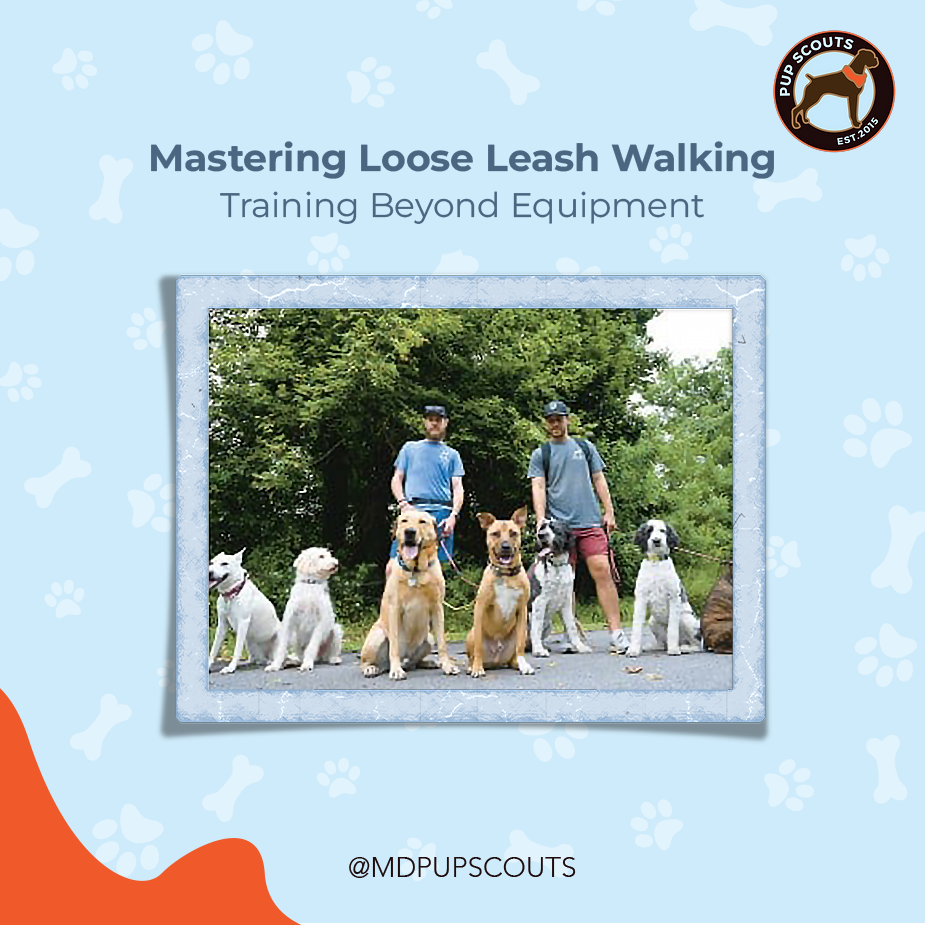Mastering Loose Leash Walking: Training Beyond Equipment

The best time to train for a loose leash is in puppyhood, but the second-best time is right now!
“Equipment doesn’t create a loose leash; training does” -Ancient Dog Training Proverb.
I often remember this saying when asked which harness or collar is best for a pulling dog. The questioner is typically an exasperated dog owner gingerly nursing their shoulder or holding on for dear life so as not to be dragged toward the nearest pee spot. “I don’t understand it,” they say, shaking their heads. “It can’t be comfortable!” This is very true, but dogs pull for various reasons, some of which may not be immediately obvious to us on the other end of the leash.

Understanding why dogs pull
Before we learn how to correct it, let’s look at some of the motivations behind pulling by exploring why dogs pull:
1. Pulling works! As puppies, pulling often isn’t corrected because it isn’t that uncomfortable for the human. As they grow, the dog learns that pulling is the best way to get where they want to be!
2. The dog pulls because when he does so, you follow. In other words: the dog learns, “Don’t follow!
3. You have previously taught your dog by using corrections. The dog has learned to pull because of the timing of your correction. For e.g. The dog pulls, we opt to teach him by pulling back on the leash. To jerk the leash, you have to slacken it for a moment; thus, the dog learns to associate the slackening with the pain of the correction. It will create a dog that is actively avoiding a loose leash.
4. Walking on a leash hurts her neck. She finds it difficult to breathe due to a tight collar, so she tries to escape by getting as far away as possible.

Walking on a tight lease hurts
5. The dog may be using a retractable leash that is always taut. The dog then gives up, trying to keep the leash loose.
6. Being dragged by your shoulder down the street doesn’t bring out the best in anyone. Painful, pulling walks can lead humans to act in ways we would never dream of. We may yell, grab them by the neck or have some other unpleasant consequence, leading to the dog trying to get as far from us as possible.
7. If your dog’s stress level is too high, the discomfort of the tight leash may not register. They are typically more active and erratic and have difficulty walking slowly and concentrating.
The best time to train for a loose leash is in puppyhood, but the second-best time is right now! Because a litany of resources has expanded upon leash work with puppies, I will devote another post to setting your puppy up for success on walks.
Adult dogs: this is for you! Time for school.

Let’s make learning new things fun
There isn’t an age limit for learning. Although young dogs learn quickly, they also forget quickly and need frequent repetition. Older dogs learn just as quickly, and new things usually stay with them. They can concentrate better and have enough life experience to see the value of being adored. I love having older dogs for training. It’s wonderful to see how well they understand when you “explain” things to them. The techniques put forward work equally well despite the age of the dog in question. Several methods and troubleshooting techniques are available, but I will start with the classic approach to a pulling pup.
Remember: Rome wasn’t built in a day. Your dog didn’t learn to become a champion puller overnight, so getting them used to the new rules will take some time. But if you remain consistent, you should see a trending improvement with every walk you take.
Take a walk!
The walk begins long before you leave the house – Confucius.
I recommend starting this exercise as a part of dog training inside and off-leash. Keeping distractions at a minimum is crucial initially, and not involving the leash will teach your dog that paying attention to you is a good bet regardless of context.
STEP ONE
Teach the dog a simple neutral sound (patting your thigh, clicking your tongue, a quick whistle, etc.) which means only one thing: “FOLLOW ME.” Teach it this way:
- Start inside or in a quiet place without distractions.
- Have the dog close and a treat ready to dispense.
- Use the sound you have decided to teach the dog.
- Dogs being naturally curious, the dog will turn toward the sound (If you cannot get the dog to turn, your environment may be too distracting).
- The moment the dog turns toward the sound, praise and treat them.
- Repeat this a few times, and he will soon learn that the sound indicates something pleasant. It may be familiar to those of you who have done clicker training. We aren’t using the clicker in this case because we aren’t always going to be pairing the sound with a treat in the future.
The dog has now learned that the signal you have chosen means he should turn to you for a reward.
STEP TWO

Praise the dog when he turns toward you
- Remaining in a quiet, distraction-free environment, make the sound.
- Praise the dog when he turns toward you, and move a few steps away from the dog.
- He will follow you to get his reward.
The dog has now learned to follow you to get a reward.
STEP THREE
- Ensure that there are still no distractions.
- Make the sound.
- Praise the dog when he turns toward you.
- Take a few steps (just 2-3), or the dog will become frustrated and give up.
- Reward the dog when he follows.
- Make the sound again and change direction.
- Repeat this three to five times in a row.
- Walk in a different direction each time; praise and treat your dog when he follows you.
The dog has now learned to follow you and walk with you where you go when you give the signal.
STEP FOUR
- Continue to work in a place with no distractions.
- The next step is to use a leash (non-retractable) and do steps one through three again.
- Always be sure to have a completely slack leash. Be aware of your hand to ensure you don’t pull or put any pressure on the leash.
The dog has now learned to follow you on a loose leash.
STEP FIVE
- Slightly increase the difficulty by moving to the backyard or another outside area while dog walking with minimal distractions.
- Now, you can gradually start to increase the difficulty of the exercise
- This includes walking a few steps further each time and changing direction frequently.
The dog is now learning to walk on a loose leash in various places.
Gradually increase the amount of time you practice from five to ten minutes, and possibly more if your dog can concentrate for that length of time. If your dog loses concentration, it is because he is tired, and you have likely worked too long. Humans know all too well that you cannot force anyone to concentrate. Raising criteria slowly helps strengthen your dogs’ attention span without frustrating them.

Step by step guide to loose leash training
STEP SIX:
- Increase the difficulty by introducing distractions
- Distractions include cars, bicycles, other dogs, children, cats, livestock etc. Always start with the distractions at a distance and gradually move closer as long as the dog is coping well.
STEP SEVEN:
- The last step is to give treats less often during the game. Switch to rewarding with food every second or third time, keeping verbal praise high. We want to vary how we use the treats, but never stop using them completely, as your dog will need a reward now and again (just like we all still need a paycheck!).
TROUBLESHOOTING:
- If the dog seems stressed, look at the whole picture. Perhaps your dog makes progress initially and then seems to deteriorate? If so, you might be training for too long. Try to have short 5–10-minute sessions in the beginning.
- Perhaps your dog does not respond to the signal. Dogs tend to become “Deaf” when stressed, so again, you must look for stress causes (including your own emotions).
- Does your dog bite the leash or your pant legs? It is also a sign of stress. A young dog will likely behave like this when tired or excited. Young dogs can easily get tired when the walk is too long. He might get excited when too much is happening around him, or perhaps the owner is asking for too much.
- Regular checkups are crucial to your dogs’ well-being. Ensure that the dog has no health problems that may cause discomfort. Pain in the back, legs or hips can create a dog that prefers to run on the leash than walk.
- Does the dog take the treat and then rocket off again? Then pause before giving him the treat, just giving him praise. Then reward him, turn and change direction more frequently to make it more interesting to follow you.

Creating a loose leash’s “default setting” allows you to relax and enjoy your walk with your dog
Conclusion
By following these steps, you will have created a dog with a vested interest in keeping the leash slack before you even leave the house. Creating a loose leash’s “default setting” allows you to relax and enjoy your walk with your dog. As you take your dog out into the world, you may find distractions that create difficulty or other behaviours that may crop up.
Many dogs have perfect leash manners until “that one thing“ pops up (for my dog, it’s foxes)! Troubleshooting leash-walking issues is a big part of what we do here at MD Pup Scouts. We can evaluate any pain points you may have and put together exercises and a training plan specific to your dogs’ needs.
We’ve barely scratched the surface of loose leash walking! I will be taking a more in-depth look in the coming weeks. In the meantime, I will be glad to answer any questions you have; please see the email below.
Happy walking, and tell your dog I said Hi!
Questions about leash walking, equipment, canine cognition or recommendations for Thai food can all be directed to Dominic@mdpupscouts.com.

Mastering Loose Leash Walking: Training Beyond Equipment
“Equipment doesn’t create a loose leash; training does” -Ancient Dog Training Proverb. I often remember this saying when asked which harness or collar is best for a pulling dog. The questioner is typically an exasperated dog owner gingerly nursing their shoulder or holding on for dear life so as not to be dragged toward the […]

